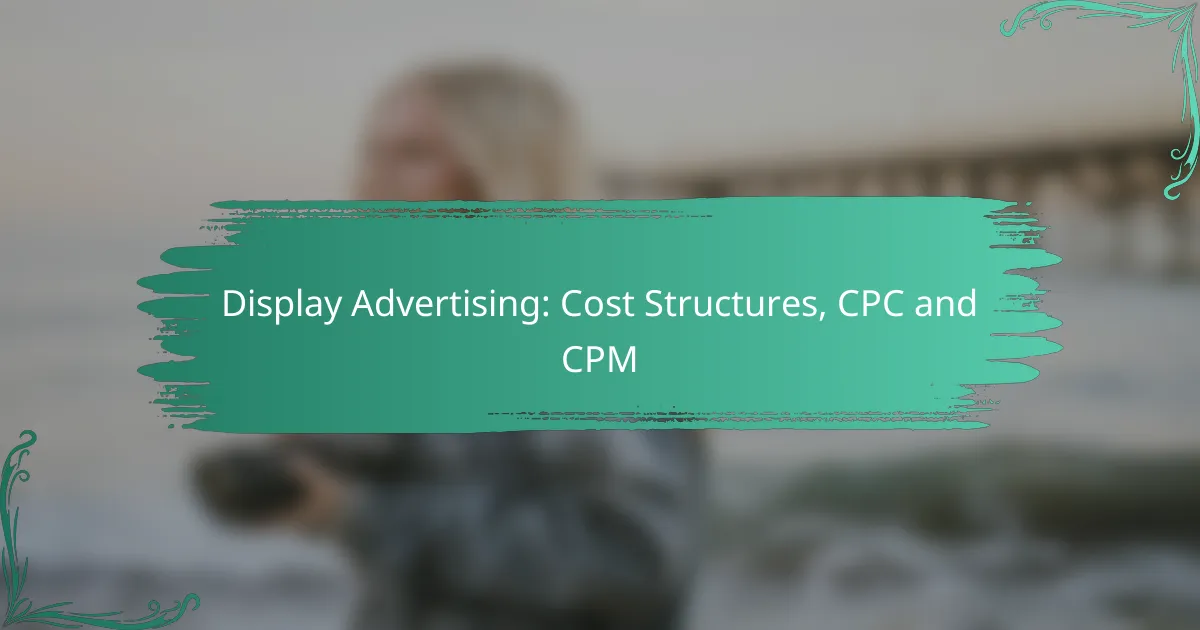Display advertising encompasses various cost structures, including CPC (cost per click) and CPM (cost per mille), each tailored to different advertising goals. CPC allows advertisers to pay only when users engage with their ads, making it ideal for performance-driven campaigns. In contrast, CPM focuses on the number of impressions, making it suitable for brand awareness initiatives. Understanding these models is crucial for effective budget allocation and campaign measurement.

What are the cost structures of display advertising?
The cost structures of display advertising primarily include CPC, CPM, flat rate pricing, and hybrid models. Each structure has its own advantages and considerations, influencing how advertisers allocate their budgets and measure performance.
CPC (Cost Per Click)
CPC, or Cost Per Click, is a pricing model where advertisers pay each time a user clicks on their ad. This model is beneficial for campaigns focused on driving traffic to a website, as it directly ties costs to user engagement.
Advertisers should consider their target audience and the average CPC rates in their industry, which can vary widely, often ranging from a few cents to several dollars per click. A well-optimized campaign can lead to a lower CPC and higher return on investment.
CPM (Cost Per Mille)
CPM, or Cost Per Mille, refers to the cost per thousand impressions of an ad. This model is ideal for brand awareness campaigns, where the goal is to reach a large audience rather than drive immediate clicks.
CPM rates can differ based on factors such as ad placement, audience targeting, and the platform used. Typical CPM rates might range from a few dollars to over twenty dollars, depending on the competitiveness of the market and the quality of the ad inventory.
Flat Rate Pricing
Flat rate pricing involves paying a fixed amount for a specific ad placement over a set period. This model provides predictability in budgeting and is often used for sponsorships or premium placements.
Advertisers should negotiate terms carefully, considering factors like the expected reach and duration of the campaign. While it offers stability, flat rate pricing may not always align with performance metrics, making it essential to evaluate effectiveness post-campaign.
Hybrid Models
Hybrid models combine elements of CPC, CPM, and flat rate pricing, allowing advertisers to tailor their approach based on campaign goals. For example, a campaign might use a flat rate for premium placements while incorporating CPC for performance-based ads.
This flexibility can optimize budget allocation and performance tracking. Advertisers should assess their objectives and audience behavior to determine the most effective mix of pricing models for their campaigns.

How does CPC work in display advertising?
CPC, or cost per click, is a pricing model in display advertising where advertisers pay each time a user clicks on their ad. This model allows advertisers to directly measure the effectiveness of their campaigns by linking costs to user engagement.
Definition of CPC
CPC stands for cost per click and is a common metric used in online advertising. It indicates the amount an advertiser pays for each click on their display ad. This model is particularly popular among businesses looking to drive traffic to their websites and generate leads.
In display advertising, CPC can vary based on factors such as the ad’s placement, the target audience, and the competition for keywords. Advertisers often set a maximum CPC bid, which is the highest amount they are willing to pay for a click.
Calculation of CPC
CPC is calculated by dividing the total cost of the ad campaign by the total number of clicks received. For example, if an advertiser spends $200 on a campaign and receives 100 clicks, the CPC would be $2.00.
To optimize CPC, advertisers should monitor their campaigns closely and adjust bids based on performance. Keeping track of metrics such as click-through rates (CTR) and conversion rates can help in making informed decisions about budget allocation and bid adjustments.

How does CPM work in display advertising?
CPM, or Cost Per Mille, is a pricing model in display advertising where advertisers pay for every thousand impressions their ads receive. This model is beneficial for brand awareness campaigns, as it focuses on the number of times an ad is displayed rather than user interactions.
Definition of CPM
CPM stands for Cost Per Mille, with “mille” meaning thousand in Latin. It represents the cost an advertiser incurs for every 1,000 impressions of their advertisement. This metric is widely used in digital marketing to assess the cost-effectiveness of ad placements.
Using CPM allows advertisers to budget effectively for campaigns aimed at maximizing visibility. It is particularly useful for campaigns focused on reaching a broad audience rather than driving immediate clicks or conversions.
Calculation of CPM
To calculate CPM, use the formula: CPM = (Total Cost of Campaign / Total Impressions) x 1,000. For example, if an advertiser spends $500 for 200,000 impressions, the CPM would be ($500 / 200,000) x 1,000, resulting in a CPM of $2.50.
Understanding CPM helps advertisers compare costs across different platforms and campaigns. It’s important to consider the quality of impressions, as a lower CPM does not always equate to better performance if the audience is not well-targeted.

What factors influence CPC and CPM rates?
CPC (Cost Per Click) and CPM (Cost Per Mille) rates are influenced by several key factors, including target audience characteristics, ad placement, and the overall quality score of the ad. Understanding these elements can help advertisers optimize their campaigns for better performance and cost efficiency.
Target Audience
The target audience significantly impacts CPC and CPM rates. Advertisers often pay more to reach specific demographics that are deemed more valuable, such as high-income individuals or niche market segments. For instance, targeting users in urban areas may result in higher costs compared to rural audiences.
Advertisers should analyze their audience’s interests, behaviors, and online habits to tailor their ads effectively. Utilizing tools like Google Analytics can provide insights into audience engagement, helping to refine targeting strategies and potentially lower costs.
Ad Placement
Ad placement refers to where the advertisement appears on a website or platform, which can greatly affect CPC and CPM rates. Premium placements, such as above-the-fold positions or within highly trafficked sections, typically command higher costs due to increased visibility and engagement potential.
Choosing the right placement involves balancing cost with expected performance. Advertisers should test various placements to determine which yields the best return on investment, adjusting strategies based on performance data.
Ad Quality Score
The ad quality score is a metric used by platforms like Google Ads to evaluate the relevance and quality of an ad. A higher quality score can lead to lower CPC and CPM rates, as it indicates that the ad is well-targeted and engaging for users.
To improve quality scores, advertisers should focus on creating compelling ad copy, using relevant keywords, and ensuring that landing pages are optimized for user experience. Regularly reviewing and refining ads based on performance metrics can help maintain or improve quality scores over time.

How to optimize display advertising costs?
To optimize display advertising costs, focus on refining targeting, enhancing ad creative, and managing bids effectively. These strategies help maximize return on investment while minimizing unnecessary expenses.
Targeting Strategies
Effective targeting strategies are crucial for reducing display advertising costs. Utilize demographic, geographic, and behavioral targeting to reach the most relevant audience, which can lead to higher engagement rates and lower costs per click (CPC).
Consider using lookalike audiences based on existing customer data to expand reach without wasting budget on uninterested users. Regularly analyze performance metrics to adjust targeting parameters and improve ad relevance.
Ad Creative Optimization
Ad creative optimization involves refining the visual and textual elements of your ads to enhance performance. A/B testing different designs, headlines, and calls to action can reveal what resonates best with your audience.
Keep your messaging clear and compelling, and ensure that your ads are visually appealing. High-quality images and concise copy can significantly improve click-through rates (CTR), ultimately lowering your overall advertising costs.
Bid Management Techniques
Bid management techniques are essential for controlling display advertising expenses. Set clear goals for your campaigns, such as target CPC or cost per thousand impressions (CPM), and adjust bids accordingly to stay within budget.
Consider automated bidding strategies that adjust your bids in real-time based on performance data. Regularly review your bidding strategy to ensure it aligns with your campaign objectives and market conditions, avoiding overspending on underperforming ads.

What are the best platforms for display advertising?
The best platforms for display advertising include Google Display Network, Facebook Audience Network, and AdRoll. Each platform offers unique features and targeting options that can help advertisers reach their desired audience effectively.
Google Display Network
The Google Display Network (GDN) is one of the largest platforms for display advertising, reaching over 90% of internet users globally. It allows advertisers to display ads on a vast range of websites, apps, and videos, utilizing Google’s extensive targeting capabilities.
When using GDN, consider the various targeting options such as contextual targeting, demographic targeting, and remarketing. Advertisers can set budgets and choose between cost-per-click (CPC) or cost-per-thousand-impressions (CPM) pricing models, making it flexible for different marketing strategies.
Facebook Audience Network
Facebook Audience Network extends Facebook’s advertising capabilities beyond its platform, allowing ads to appear on third-party apps and websites. This network leverages Facebook’s rich user data for precise targeting, making it effective for reaching specific demographics.
Advertisers can choose from various ad formats, including native ads and banner ads, and can utilize CPC or CPM pricing. It’s essential to monitor performance metrics closely, as engagement can vary significantly across different placements within the network.
AdRoll
AdRoll specializes in retargeting, helping businesses re-engage users who have previously interacted with their website or app. It provides cross-channel advertising solutions that include display ads, social media ads, and email marketing.
With AdRoll, advertisers can easily set up campaigns and track performance across multiple platforms. The pricing structure typically involves CPM, and users should focus on optimizing their retargeting lists to maximize conversion rates. Regularly updating creative assets can also enhance ad effectiveness.
